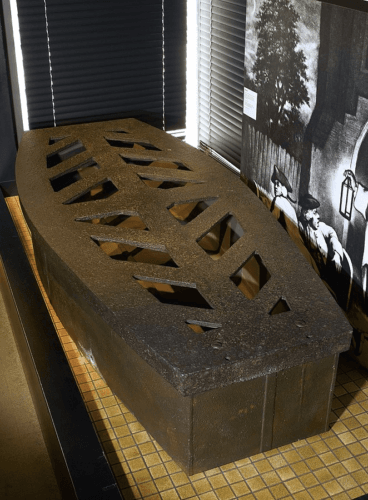What is a Mortsafe?

Iron mortsafe 1801-1822.Wellcome Images Creative Commons Attribution 4.0 International
In Here There Be Dragons, Anne Wentworth rented a mortsafe to protect a grave. So then, what is a mortsafe and what sort of protection did it provide?
A mortsafe or mortcage was a heavy construction, usually made of stone or iron, used protect graves from disturbance.
That’s simple and straightforward enough, but what did the graves need protection from?
During the 18th and 19th century, Great Britain and the United States suffered a rash of grave robberies by resurrection men who sold the stolen bodies to medical schools for dissection. The root of the problem was that the only legal source of corpses for study came from executed criminals and demand outpaced supply.
Interestingly, until the Anatomy Act of 1832, the taking of corpses from graves was not, in and of itself illegal, as a corpse was neither owned nor had any legal standing on its own. However, taking the shroud around the body or any other grave clothing was illegal. The practice was considered morally and religiously reprehensible, though, as was dissection, even if the purpose was for medical education.
Although authorities often turned a blind eye to grave rifling and attempted to keep publicity about the cases to a minimum, those cases which did come to light often caused riots, property damage, and even fatal encounters. But with a profit to be made from selling the bodies, the desecration continued.
What was a grieving family to do? Large stones were sometimes placed over graves, but that just encouraged resurrectionists to dig alongside them and break into the coffins to remove bodies. Families added straw, tree limbs and rocks to the dirt covering the grave to slow down the grave robbers, but that served as a weak deterrent at best. Posting watches over the grave yards proved equally ineffective.
Enter the mortsafe. Invented around 1816, these heavy, iron or iron and stone contraptions presented formidable barriers to even the most determined grave robbers, thus securing bodies in their coffins to decay and become useless to anatomists. Because of the expense associated with these products, parishes often purchased one or two mortsafes to be shared among the parishioners. Mortsafe “societies” would pool their resources to purchase one or more mortsafes to be shared among their members, and even making money on their purchase by renting them out to non-members.
Why did Anne Wentworth rent one? For that you’re going to need to check out Here There Be Dragons.
References
Meier, Allison, C. Beating the bodysnatchers. Wellcome Collection. June 14, 2018. Accessed August 17, 2023 https://wellcomecollection.org/articles/WxfvsiQAACcAY5Kp
Trying to Stop the Body Snatchers with a Mortsafe. History House. Accessed August 1, 2023. https://historyhouse.co.uk/articles/mortsafes.html

Very interesting, Maria Grace. But I’m still a little unclear. Did these things lock? Or was the top just too heavy for easy lifting? And, morbid curiosity, how long did they wait before digging one up, emptying the decayed remains, and sharing it with someone else? A very weird custom.
Some may have locked, but many were just set on top of the grave site, to heavy to move without special equiptment, like a block and tackle. Since many were over the top of the grave, the did not need to be emptied out, just removed and placed on another grave. The usual time table for this, as I understand was about 6 weeks.